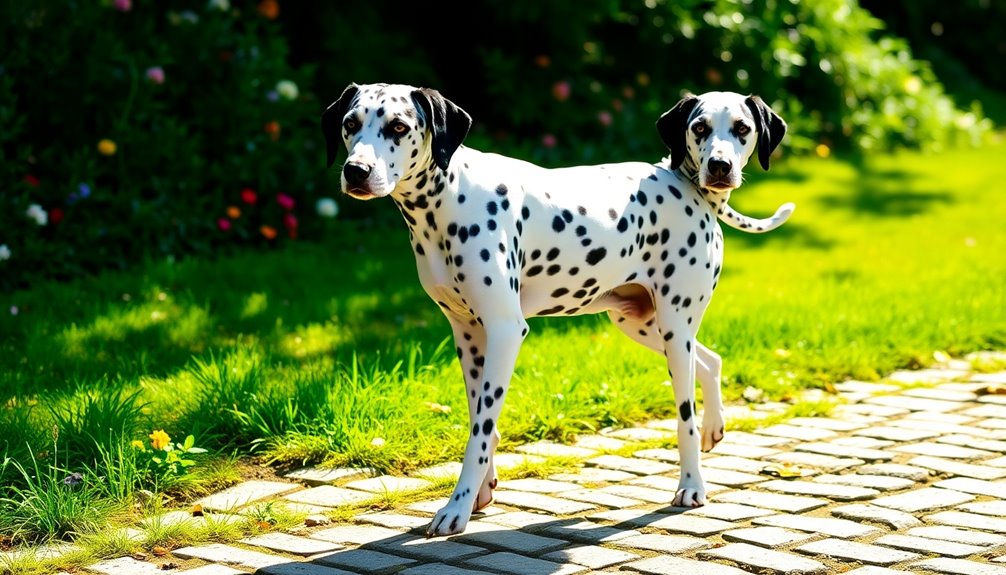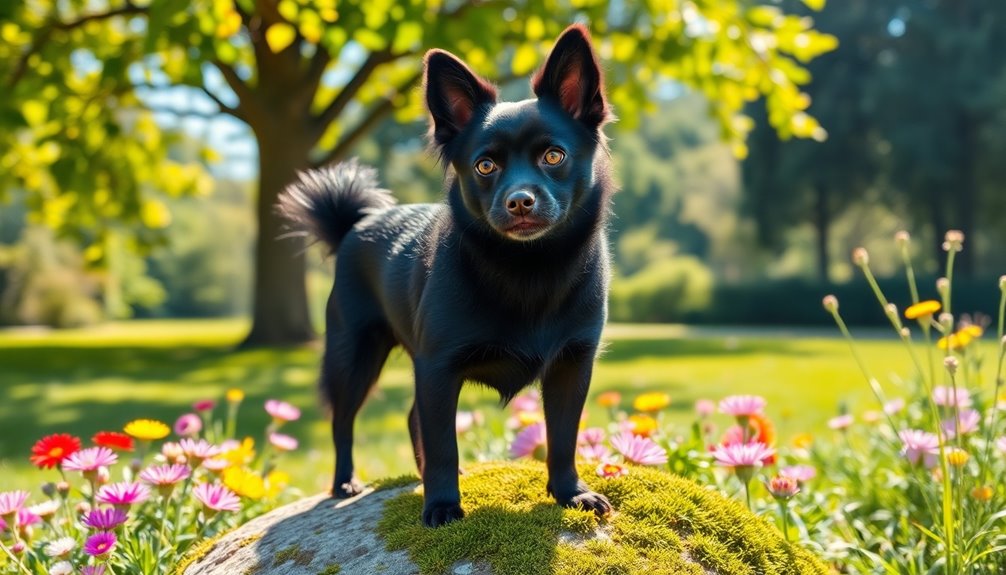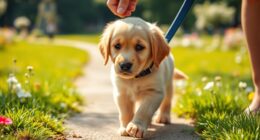Dachshunds are often called the iconic hot dog breed because of their elongated shape and playful personality. These charming dogs, originating from Germany, are known for their loyalty and curious nature. They come in standard and miniature sizes, along with three coat types: smooth, long-haired, and wire-haired, each requiring different grooming. Though they thrive on companionship and love interaction, their stubborn streak can make training challenging. Daily exercise is essential to keep them healthy and happy, making them a perfect fit for families with older kids or single adults. Discover more about their care and characteristics as you explore!
Key Takeaways
- Dachshunds, often called "hot dogs," have a unique elongated body and short legs, making them instantly recognizable.
- Originating in Germany as hunting dogs for badgers, their name translates to "badger dog" in German.
- They come in standard and miniature sizes, with varying coat types: smooth, long-haired, and wire-haired, each requiring different grooming.
- Known for their playful and curious nature, Dachshunds thrive on companionship and need consistent training to overcome stubbornness.
- Their moderate exercise needs and adaptability make them suitable for urban living, though care should be taken to protect their backs.
Introduction
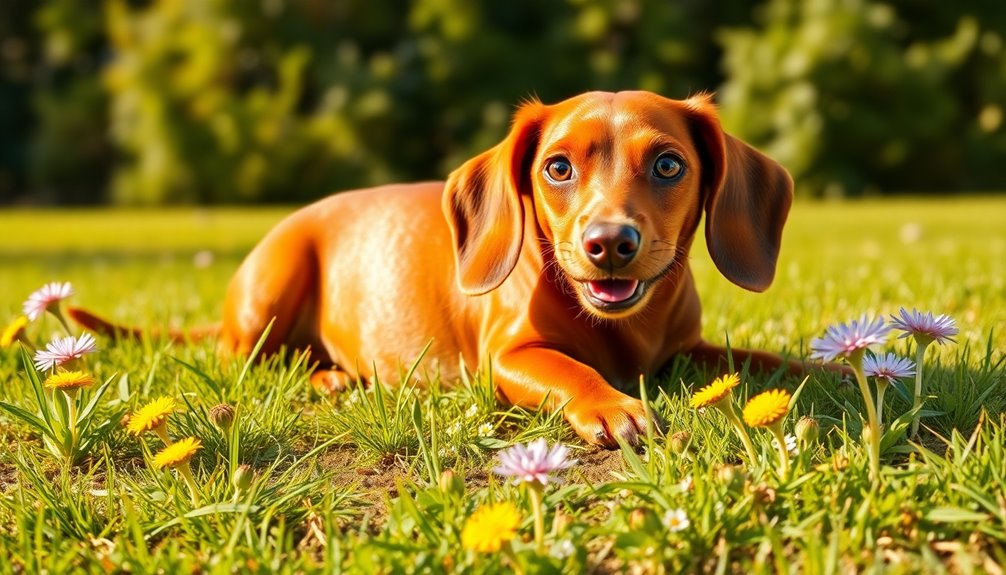
When you think of iconic dog breeds, the Dachshund often springs to mind. Known for their unique elongated bodies and short legs, these dogs stand out in any crowd. You might notice their large, floppy ears and extended muzzles, which add to their distinct charm.
Dachshunds come in various sizes—standard, miniature, and even kaninchen, or rabbit-sized—making them a versatile choice for many dog lovers. Their coat varieties are just as captivating, with options such as smooth, wire-haired, and long-haired. You could find them in colors like black, chocolate, brindle, or dapple—each one showcasing their personality. Additionally, they are available in two distinct sizes—standard and miniature—providing further options for potential owners.
Despite being average shedders, their grooming needs vary based on their coat type. However, owning a Dachshund comes with responsibilities. They're prone to certain health issues, particularly intervertebral disc disease (IVDD), so you'll need to manage their weight and exercise carefully.
Regular moderate walks can keep them happy and healthy, while avoiding stairs and jumps helps protect their backs. With the right care and attention, a Dachshund can become a loyal, courageous companion that brings joy to your life.
History and Origin
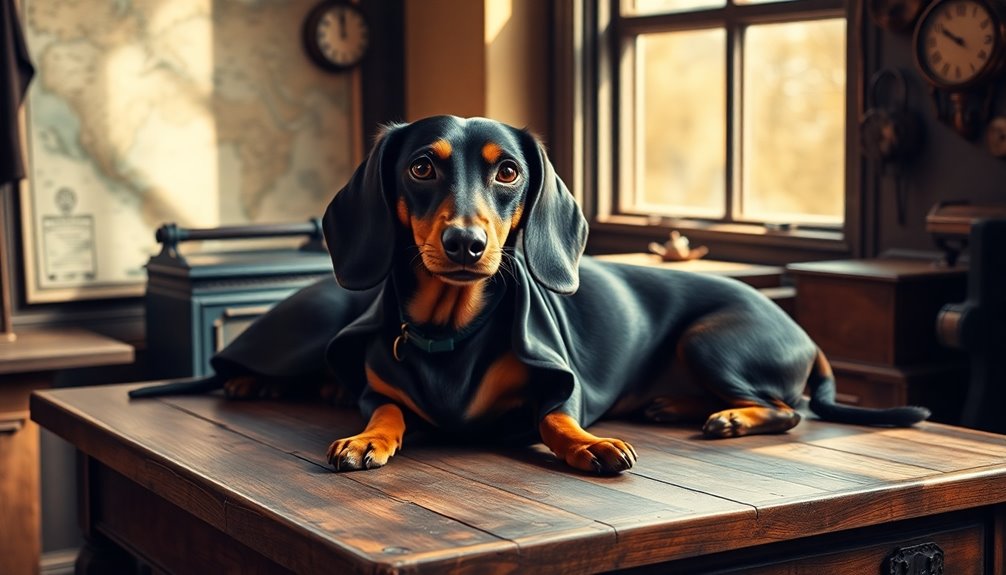
Dachshunds trace their roots back to Germany, where they were originally bred as hunting dogs. Their unique design, perfect for burrowing, made them skilled at hunting badgers and other underground prey. As you explore their history, you'll discover how these dogs became beloved companions while retaining their adventurous spirit. Their clever and playful nature has contributed to their popularity as family pets since the 1930s.
Where and when the breed originated
The iconic Dachshund, often affectionately referred to as the "badger dog," has its roots deeply embedded in Germany's dense forests. This breed originated in Germany, with its history tracing back to the 15th century. Early breeding involved local hounds and terriers, influenced by various regions across the country. The name "Dachshund" directly translates to "badger dog" in German, highlighting its original purpose.
Significant development of the breed began in the 17th century, leading to the first official records appearing in the 15th, 16th, and 17th centuries. By 1879, standardization of the Dachshund took place, ensuring consistency in appearance and temperament. The breed's unique shape was designed to assist in hunting tasks, allowing them to burrow into small spaces during hunts.
The breed made its way to the United States between 1870 and 1885, thanks to German immigrants who brought their beloved dogs along. In 1885, the American Kennel Club (AKC) recognized the Dachshund, with "Dash" being the first to enter the AKC Stud Book.
The Dachshund Club of America was organized in 1895, establishing a community dedicated to this charming breed. As time passed, the Dachshund gained popularity, becoming a beloved companion in homes across America.
Badger Hunting and Burrowing
Training modern Dachshunds often involves tracking deer using blood trails, benefiting from socialization with experienced dogs. Their keen abilities make them excellent companions for hunters today, signaling the end of scent trails and ensuring the legacy of their burrowing ancestors lives on. In fact, the name "Dachshund" translates to "badger dog" in German, highlighting their historical role in hunting.
Physical Characteristics
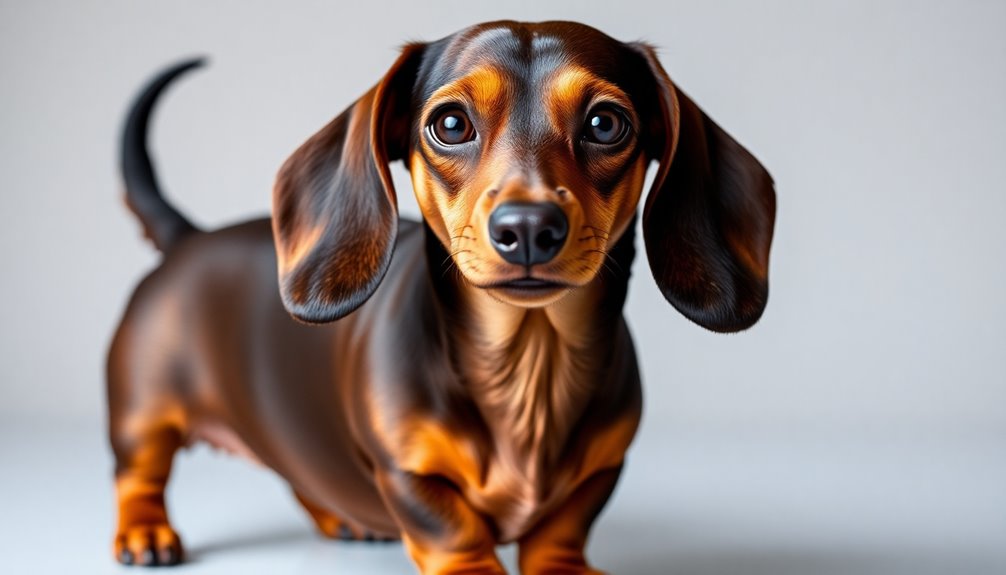
When you look at a Dachshund, you can't help but notice their unique size and shape.
With their elongated bodies and short, strong legs, they come in various sizes, from miniature to standard.
Plus, their long, droopy ears add to their charming and expressive appearance. Additionally, their diverse coat colors and patterns, including two colored combinations, contribute to their distinctive and appealing look.
Size, weight, and coat details
Dachshunds come in two main sizes: standard and miniature, each with distinct characteristics. Standard Dachshunds typically stand 8-9 inches tall at the withers, while miniature ones measure about 5-6 inches. These heights are taken from the ground to the top of the shoulder blades, and individual dogs may vary due to genetics, health, diet, and exercise. Their short stature is a result of being bred for hunting badgers.
In terms of weight, standard Dachshunds usually weigh between 16-32 pounds, reaching their full weight around 12 months. Miniature Dachshunds, on the other hand, weigh less than 11 pounds. Various factors, including genetics and lifestyle, can affect their weight, and it's important to monitor their weight regularly to avoid obesity-related issues.
When it comes to coats, Dachshunds boast three main types: smooth, long-haired, and wire-haired. Smooth-coated Dachshunds have short fur with low grooming needs. Long-haired Dachshunds feature flowing locks that require regular brushing, while wire-haired ones possess a coarse outer coat and dense undercoat, needing regular stripping or plucking.
Each coat type also comes in various colors and patterns, including dapple, brindle, and piebald, adding to the breed's unique charm.
Long, Droopy Ears
One of the most distinctive features of the Dachshund is its long, droopy ears, which not only contribute to its unique appearance but also play a functional role in the breed's hunting background.
These ears are formed by a combination of the ear flap and ear canal, designed to collect and channel sound waves effectively. However, their structure can also make them susceptible to ear infections. The long, floppy ears trap moisture and debris, especially given your Dachshund's short legs, which often expose them to damp environments like grass or mud. Additionally, the warm, dark ear canals create an ideal breeding ground for bacteria and yeast, increasing the risk of infections.
To keep your furry friend healthy, it's essential to regularly inspect their ears for signs of infection. Look out for persistent scratching, unusual head tilting, or any abnormal discharge.
Proper cleaning using vet-approved ear cleaners and ensuring their ears are dry after baths or swimming can help prevent issues. Additionally, grooming ear hair reduces moisture trapping.
Temperament and Personality
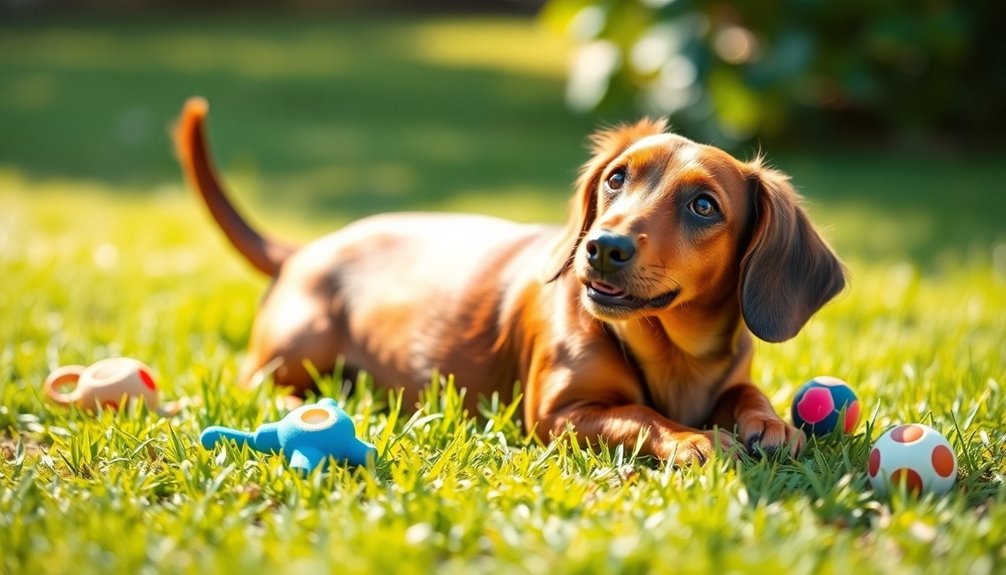
Dachshunds are playful and curious, making them a joy to have around whether you're a family, an individual, or a household with other pets. Their lively nature means they thrive on interaction and can fit well into various lifestyles. Just keep in mind their unique personality traits when considering how they'll mesh with your home. Proper socialization from a young age is essential to ensure they adapt well, especially when interacting with larger breeds.
Playful and Curious Nature
There's something undeniably charming about the playful and curious nature of these little dogs. Dachshunds thrive on fun and adventure, eagerly running around and exploring their surroundings.
You'll find they're easily entertained by a variety of toys—chew toys, squeaky toys, and balls are their favorites. Natural chews like antlers and animal ears not only satisfy their need to chew but also keep them engaged.
Their lively spirit and high energy make play essential for their daily exercise. You'll notice that these intelligent pups are quick learners, although they can be a bit stubborn at times. When training them, positive reinforcement works wonders, and they love the challenge of mental stimulation games like puzzles and snuffle mats. Their intelligence and trainability allow them to excel in learning new tricks, making playtime an opportunity for skill development.
Thanks to their bold and fearless nature, often rooted in their hunting background, Dachshunds are persistent in pursuing their interests. They might dig, bark, or chase small animals, displaying their inherent traits.
Yet, amidst all this energy, they also seek cuddles and affection, making them delightful companions. Their playful curiosity keeps life vibrant and entertaining, ensuring that every day with them is filled with joy and laughter.
Suitability for families, individuals, or other pets
How well do Dachshunds fit into various living situations? These adorable pups thrive best in families with older children who can be gentle. Their small size makes them vulnerable to injuries from rough handling, so it's wise to avoid young kids. If you have younger children, supervision is essential during interactions.
Dachshunds love company and attention, making them less suitable for busy families who are often away from home. They require significant mental and physical stimulation due to their high-energy levels.
For single adults, Dachshunds can be an excellent match. They require patience and prior dog experience, as socialization is key to curbing their suspicion of strangers. Regular exercise, like a couple of half-mile walks daily, makes them perfect for urban living.
When it comes to other pets, Dachshunds generally enjoy the company of dogs, especially if introduced properly. They tend to prefer smaller dogs and can coexist with larger breeds if socialized well.
However, be cautious with cats or smaller animals due to their prey drive. Supervised interactions and secure spaces are crucial to ensure everyone feels safe.
With the right environment, Dachshunds can fit seamlessly into your home, bringing joy and companionship.
Health and Lifespan
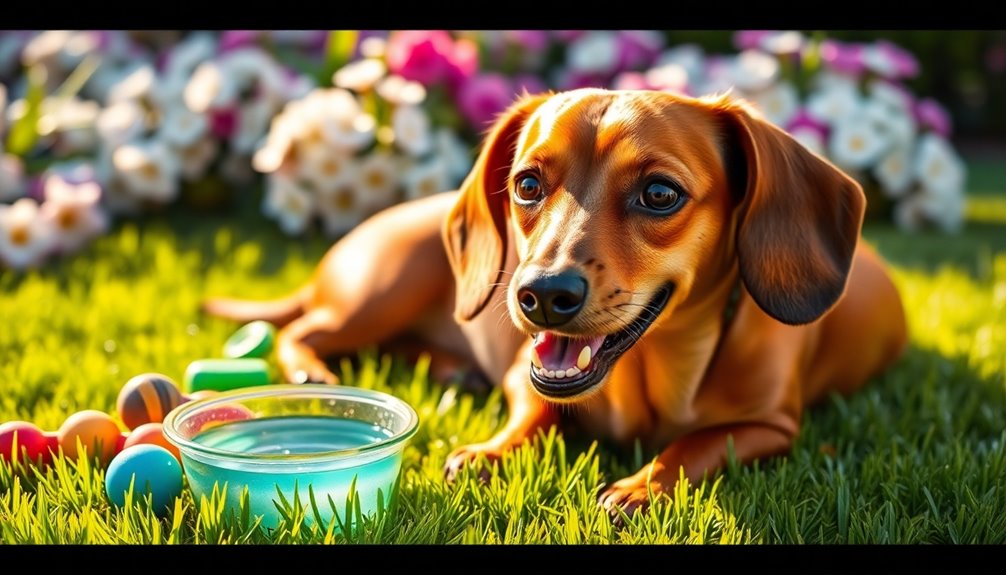
When you bring a Dachshund into your home, it's important to be aware of their typical lifespan, which ranges from 12 to 16 years. These charming dogs can face common health concerns, including spinal issues and heart defects, that can impact their quality of life. Approximately 20-25% of Dachshunds develop intervertebral disk disease, highlighting the need for careful management of their health.
Typical lifespan of the breed
The typical lifespan of a Dachshund ranges from 12 to 16 years, making them one of the longer-lived dog breeds. On average, you can expect your Dachshund to live around 12.5 years, which is about 1.5 years longer than the average dog. Many Dachshunds even reach ages of 15, 16, or 17 years, showcasing their longevity. Their small size contributes to their ability to outlive larger breeds, placing them among the longest-lived dog breeds.
To maximize your Dachshund's lifespan, several factors come into play. Proper care, including meeting their nutritional, physical, and mental needs, is essential. The breeding history and genetics also matter, as does providing a safe, healthy living environment. Regular veterinary visits and timely medical treatments can prevent potential health issues, while a good exercise regimen and quality food support overall well-being. Health issues such as obesity and spinal problems can significantly shorten their lifespan if not managed properly.
As your Dachshund ages, they transition through distinct life stages, with the senior stage typically starting around 10 years old. During this time, it's crucial to monitor their health, as more than 20% of Dachshunds succumb to complications of old age.
Regular grooming and dental care can also enhance their quality of life.
Common health concerns or genetic predispositions
As Dachshunds age, they can face various health concerns that may impact their quality of life and longevity. One major issue is Intervertebral Disc Disease (IVDD), which is common due to their elongated spines. The *FGF4*-12 mutation leads to premature degeneration of the intervertebral discs, increasing the risk of herniated or slipped discs and resulting in mobility loss or even paralysis.
Cardiovascular problems, like Degenerative Mitral Valve Disease (DMVD), typically arise between 8-10 years of age. These heart valve issues can be managed with medication, but you'll need regular vet checkups to monitor your Dachshund's heart health. Dachshunds rank among the top breeds at risk for obesity, so keeping your pup at a healthy weight is crucial.
Neurological disorders, including epilepsy and Lafora Disease, are also concerns. These conditions may require ongoing treatment and can cause recurring issues.
Additionally, be on the lookout for dental disease, skin allergies, hip dysplasia, and Progressive Retinal Atrophy (PRA), which can lead to blindness. Understanding these genetic predispositions will help you provide the best care for your beloved Dachshund.
Tips for maintaining health and wellness
To ensure your Dachshund enjoys a long and healthy life, focus on a balanced approach that includes proper nutrition, regular exercise, grooming, and veterinary care.
Start with a high-quality diet tailored for small breeds, providing ½ to 1½ cups of dry food daily, split into two meals. Look for real meat as the first ingredient, avoiding fillers and artificial preservatives. A balanced diet should include 20-30% protein, 10-15% fats, and 30-70% carbohydrates. Maintaining their ideal weight is crucial to prevent health issues, as obesity can lead to serious health problems in dogs.
Exercise is crucial, too—aim for 30-60 minutes each day. Incorporate short play sessions in the yard, swimming, or activities like walking and obstacle courses to keep them engaged. This helps prevent boredom and destructive behavior.
Grooming shouldn't be overlooked. Check your Dachshund's eyes, ears, and feet weekly, keep nails trimmed, and brush their teeth once all adult teeth are in. Use appropriate brushes for long and wire-haired breeds.
Finally, regular veterinary visits are essential for early detection of health issues. Keep an eye on their weight to prevent obesity and related complications.
With dedication to these areas, you can help your Dachshund thrive!
Care Requirements
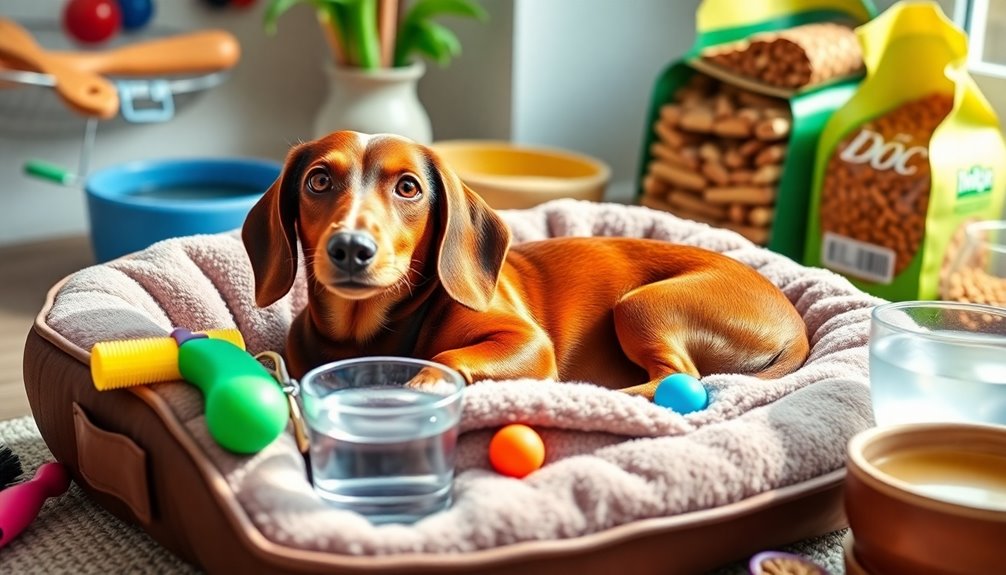
Caring for your dachshund involves understanding their grooming needs, exercise requirements, and dietary preferences.
You'll want to brush their coat regularly based on its type, ensuring you employ effective grooming tools to manage shedding, and feed them a balanced diet tailored to their age and health. Additionally, establishing a consistent routine for feeding and bathroom breaks will help your dachshund feel secure in their new environment.
Keeping these care requirements in check will help keep your furry friend happy and healthy.
Brushing Frequency for Coat Care
Maintaining the coat of your Dachshund requires attention to brushing frequency, which varies by coat type.
For Smooth-Haired Dachshunds, brushing 1-2 times per week is recommended. Use a soft-bristled brush or grooming mitt, and be gentle to remove loose hair while maintaining the coat's shine. With their short coats, you won't encounter frequent tangles or matting. Regular brushing can help maintain a shiny coat that reflects their health.
If you have a Long-Haired Dachshund, aim for at least weekly brushing, but daily brushing is ideal. A slicker brush will help prevent tangles and matting, especially behind the ears and around the tail. During shedding season, daily brushing is key to removing the undercoat and keeping the coat in good condition.
For Wire-Haired Dachshunds, you'll need to brush several times a week. Use a slicker brush for regular maintenance and to detangle the undercoat. Hand-stripping a few times a year will help maintain that wiry texture.
Regular brushing not only removes loose hair but also prevents matting, ensuring your Dachshund looks their best. Remember to incorporate ear cleaning and nail trimming into your grooming routine for overall health.
Exercise requirements and energy levels
Dachshunds are energetic little companions that thrive on regular exercise to keep them healthy and happy. For puppies, aim for about 5 minutes of exercise for each month of age, up to 12 months. Start with light play in your home or backyard before introducing walks around 4-6 months old. Ensure they get plenty of rest to lay a solid foundation for adulthood.
Once your dachshund reaches adulthood, standard breeds need at least an hour of exercise daily, while miniatures require at least 30 minutes. Engaging them in various activities like neighborhood walks, playtime, or even agility courses can also support their overall health. Remember to monitor their energy levels; avoid pushing them too hard to prevent injury.
For older dachshunds, reduce the intensity and aim for about 30 minutes of slower-paced exercise each day. Shorter, more frequent walks can be beneficial, helping maintain muscle strength and manage age-related health issues. Always consider individual differences in energy and exercise preferences, as each dachshund has unique needs. Regular exercise not only helps in keeping them fit but also supports their mental well-being.
Feeding tips and diet recommendations
Regular exercise is just one part of keeping your dachshund healthy; nutrition plays a significant role too. When choosing dog food, select a high-quality option specifically tailored for dachshunds. Avoid fillers like corn, wheat, and soy, and ensure real meat is the first ingredient. Steer clear of foods high in sugar, salt, or artificial ingredients. A mix of wet and dry food can provide variety in your pup's diet.
Aim for a balanced diet where protein comprises 20-30%, fats 10-15%, and carbohydrates 30-70%. Ensure adequate calcium (at least 0.5%) and phosphorus (at least 0.4%) for strong bones. Don't forget vitamins and minerals for overall health! Balanced diets contribute to healthier skin and shinier fur.
Consider your dachshund's life stage. Puppies need higher protein and fat for growth, while adults require food that supports muscle tone and joint health. Senior dogs benefit from chondroitin and glucosamine for joint care. If your pup has a sensitive stomach, a limited-ingredient diet is best.
Avoid table scraps and toxic foods like grapes, chocolate, or onions. Safe treats include cooked meats, apples, and carrots. Peanut butter without sugar or xylitol is also a great option!
Training and Socialization
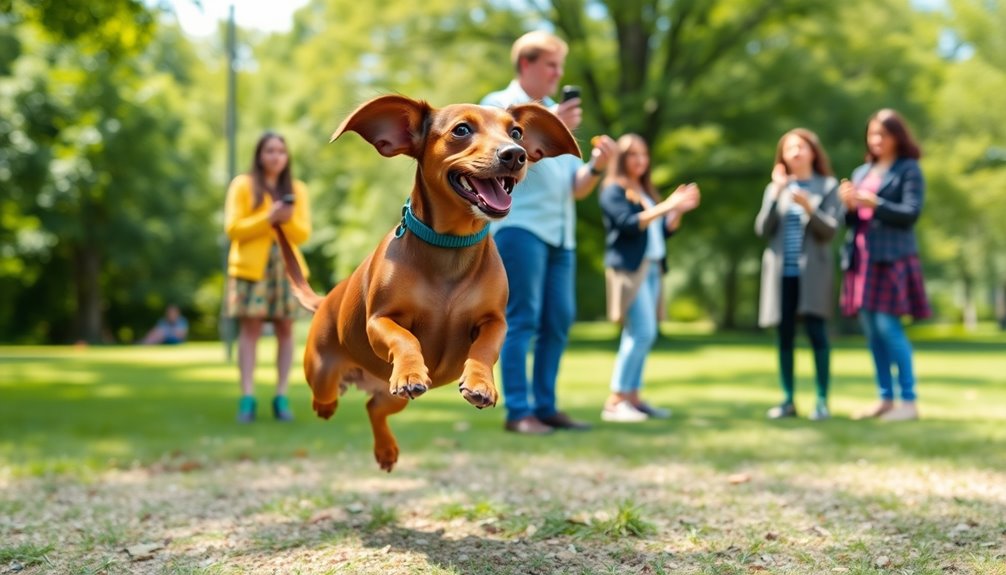
Training your Dachshund can be a bit challenging due to their stubborn nature, which might slow down progress. Using positive reinforcement during introductions helps create a positive experience and strengthens your bond. Additionally, be prepared for housebreaking difficulties, as consistency is key to overcoming this common hurdle. Regular vet check-ups are also essential to address any potential health issues that could impact your Dachshund's training progress.
Stubbornness Can Hinder Progress
Navigating the stubbornness of a Dachshund can significantly hinder your progress in training and socialization. Their independent nature, rooted in their history as hunting dogs, can lead to challenges when you try to teach them commands. If they haven't received adequate training, they mightn't understand what you expect from them, and misunderstandings can add to their stubbornness.
Stressful situations, such as loud noises or new environments, can also distract them, making obedience even tougher. You may find yourself spending longer than anticipated on training a single command, which can be frustrating. Additionally, their need for mental stimulation means that without engaging activities, they may become more resistant to following commands.
It's crucial to maintain consistency in your training methods to manage their behavior effectively. Patience is vital; the risk of giving up on your Dachshund is real, especially when they refuse to comply.
To navigate this stubbornness, keep training sessions short, fun, and engaging. Use positive reinforcement to encourage good behavior, and don't hesitate to seek professional help if needed.
Positive Reinforcement During Introductions
When introducing your Dachshund to new experiences or environments, utilizing positive reinforcement is essential for building confidence and encouraging desired behaviors. Start by identifying specific behaviors you want to encourage, like sitting on command or fetching a ball.
Begin with simple tasks and gradually increase complexity as your Dachshund masters each step. Use clear, consistent commands to avoid confusion, and reward the behavior immediately after it's performed to create a strong association.
Choosing the right rewards is crucial. Use your Dachshund's favorite treats, games, or praise to motivate them to repeat the behavior. Consider clicker training for precise timing and vary the rewards to keep things interesting. Additionally, incorporating Montessori-inspired elements into your training environment can enhance your Dachshund's learning experience.
Gradually expose your Dachshund to new stimuli in a controlled manner, using treats and praise to reinforce positive associations. Always monitor your dog's body language for signs of stress, adjusting the exposure intensity if needed. Additionally, remember that positive reinforcement is not just about rewards; it's also about creating a supportive environment that fosters growth.
Consistency and patience are key. Maintain a regular training schedule and keep sessions short and engaging. Avoid over-rewarding, as it can confuse your Dachshund and reduce the value of rewards.
Housebreaking Difficulties
Housebreaking a Dachshund can be a challenging yet rewarding journey for any pet owner. To make this process smoother, establish a routine. Take your Dachshund out consistently—upon waking, after meals, after playtime, and before bed.
Puppies, in particular, need frequent breaks due to their small bladders, so aim for every hour if possible. Always return to the same spot to help your dog associate the area with bathroom time, and use a consistent verbal command to signal the need to go out.
Watch for signs like sniffing or circling; act immediately to prevent accidents. Training your Dachshund to ring a bell can also clarify when they need to go outside. Establishing a routine of bathroom breaks can significantly reduce the likelihood of accidents indoors by reinforcing bathroom habits.
Remember, accidents will happen. Avoid punishment; instead, focus on positive reinforcement and patience. When you can't supervise, use a gated area or playpen to minimize mishaps.
Lastly, if setbacks occur, increase potty breaks and rule out any medical issues that might affect their bathroom habits. Consistency and early socialization are key in avoiding behavioral problems down the line.
With time and dedication, your Dachshund will become a pro at housebreaking!
Ideal Living Environment

If you're living in an urban apartment, a Dachshund can be the perfect companion for you. Their small size makes them well-suited for confined spaces, but you'll need to ensure they get regular walks to stay happy and healthy. Dachshunds are known for their playful and feisty nature, which makes them great companions for active individuals. To keep them in optimal health, it's essential to provide them with a proper diet and exercise routine. While they can handle warmer weather, it's important to keep an eye on them to prevent overheating.
Urban Apartment Living
Urban apartment living can be a perfect match for Dachshunds, thanks to their compact size and adaptability. These little dogs don't need a lot of space; around 10-15 square feet can suffice, making them ideal for cozy environments.
With proper exercise and mental stimulation, your Dachshund can thrive in an urban setting. Daily walks and playtime are essential to meet their moderate exercise needs. You can easily fulfill this in smaller spaces, like apartment corridors or nearby parks. Additionally, their moderate exercise needs make it easy to manage their activity levels within the constraints of apartment living.
Keep in mind that mental engagement is just as important, so consider interactive toys and games to keep them entertained.
Though Dachshunds adapt well, they do have specific health needs, such as preventing obesity and monitoring for back issues. Regular vet check-ups and proper training are vital to ensure they don't develop unwanted behaviors from a lack of space or exercise.
Lastly, socialization is key to helping them interact well with neighbors and other pets in your building. If you're committed to providing love and care, your Dachshund will indeed flourish in your urban apartment lifestyle.
Hot Weather Tolerance
While your Dachshund thrives in an urban apartment, hot weather can pose challenges for this breed. Dachshunds can stay outside in the heat, but only for short periods—preferably during the early morning or evening when temperatures are cooler. Their higher body temperature and reliance on panting to cool down makes them susceptible to heatstroke, especially if they're overweight or older.
To keep your Dachshund safe, avoid walking them during the hottest part of the day. Instead, opt for brief walks in the cooler hours and provide plenty of breaks in shaded areas. Monitor their water intake and ensure they stay hydrated. If you notice signs of overheating like excessive panting or drooling, seek veterinary care immediately.
Be cautious about sunbathing; Dachshunds love basking in sun patches, but they can overheat without realizing it. Additionally, remember that long-haired and wire-haired Dachshunds can struggle more in the heat than smooth-haired ones. This is due to their attraction to the sun and their limited cooling methods, which can lead to serious health risks if not managed properly.
Always provide a cool environment indoors, especially during extremely hot days, to help your furry friend stay comfortable and safe.
Dachshunds Have Three Coat Types
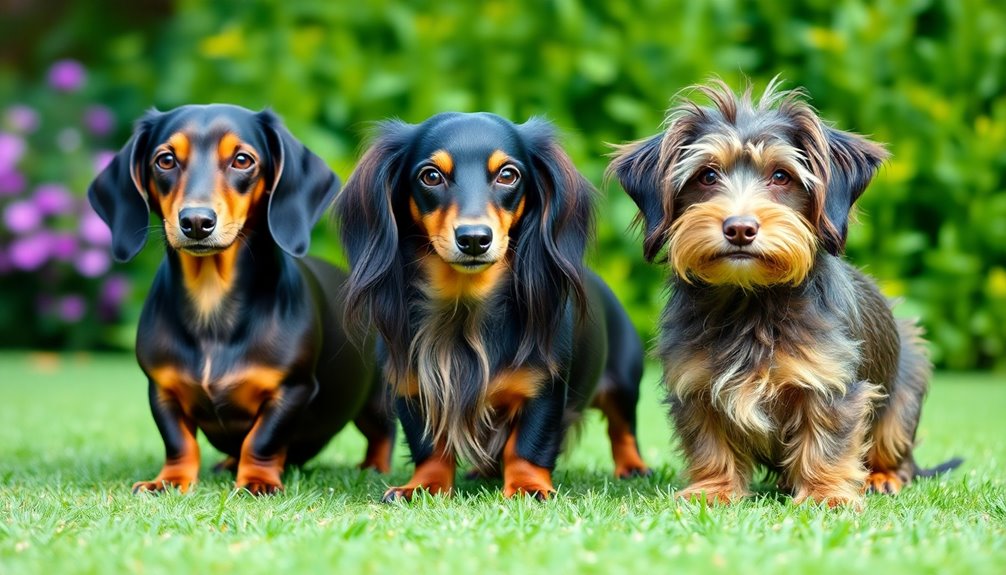
Dachshunds come in three distinct coat types, each reflecting their versatile hunting background. Whether you're drawn to the smooth, longhaired, or wirehaired variety, each has its charm and unique grooming needs. All varieties must conform to specified breed characteristics, and their iconic look has made them a favorite in cartoons, solidifying their place in popular culture.
Versatile Hunting Background
Historically, the Dachshund's unique hunting background has shaped its physical characteristics and coat types. Bred primarily to hunt badgers and other ground-burrowing animals, their name literally means "badger dog" in German. This specialized purpose required short legs to fit into burrows and curved limbs for effective digging.
You'll notice their well-angled shoulder and upper arm, which provide the range of motion essential for hunting. Dachshunds possess short legs and narrow bodies tailored for tracking scents and maneuvering into tight spaces. Their prominent bridge bone over the eyes protects their vision, while a strong underjaw and large teeth are perfect for dealing with prey.
The long ribcage extends beyond the elbow, safeguarding vital organs and offering endurance during long hunts. This endurance is crucial, especially when encountering badgers in their burrows, as Dachshunds often exhibit fearless behavior in these situations.
Dachshunds come in three distinct coat types: smooth, wirehaired, and longhaired. Each type reflects their rugged history and hunting prowess. The smooth coat, originally the most popular, is short and shiny, while the wirehaired features a rough outer layer and distinctive facial furnishings.
Longhaired Dachshunds require similar grooming, with variations in maintenance needs. Regardless of coat type, regular grooming is essential for their health and appearance.
Wiener Dog in Cartoons
In countless cartoons, the Dachshund, affectionately known as the "wiener dog," often steals the spotlight with its unique appearance and playful personality.
These adorable characters are usually depicted with their distinct coat types, each adding to their charm. Whether they're the sleek, smooth-coated wiener dogs zipping through the scenes or the fluffy longhaired ones, each brings its own flair to the story. Wire-haired coats are also represented in some cartoons, showcasing their bristly texture and unique appeal.
Cartoonists love to play with the Dachshund's colors and patterns, showcasing everything from classic black and tan to more whimsical dapple or brindle designs.
You'll often see these colorful pups getting into hilarious situations, emphasizing their curious nature.
The grooming needs of the characters mightn't always be highlighted, but you can bet that the smooth-coated wiener dogs are low on maintenance compared to their wirehaired and longhaired friends.
This variety in coat types allows for a delightful range of personalities in cartoons, making them even more relatable.
Is This Dog for You?
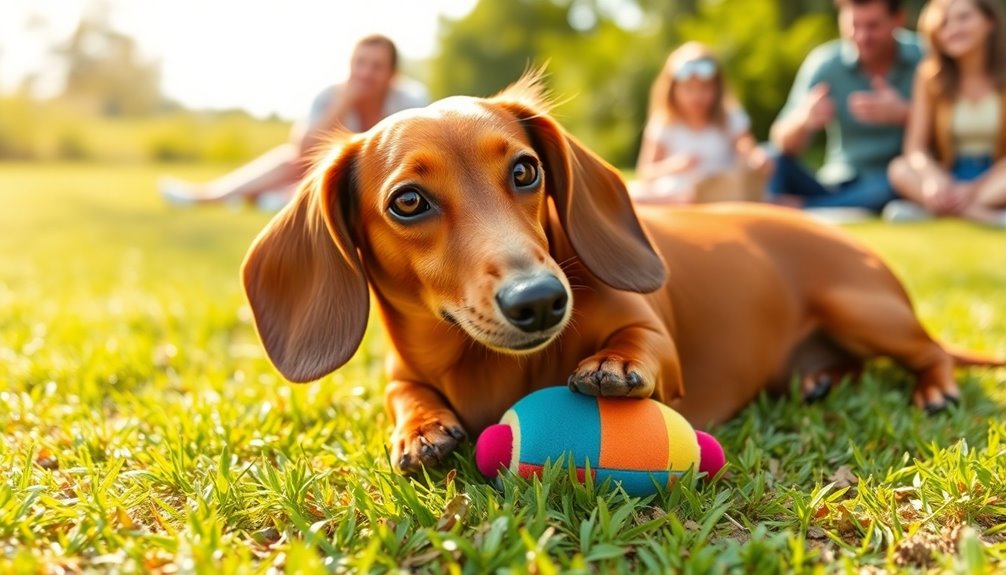
If you're looking for a family-friendly dog that's also a bit independent, a dachshund might be a great fit for you. Keep in mind that they can be quite vocal, often barking due to their hunting instincts. Consider whether you're ready for a pet that combines loyalty with a spirited personality. Additionally, dachshunds were originally bred as badger hunting dogs, which contributes to their energetic and curious nature.
Family-Friendly yet Independent
Dachshunds are the perfect blend of family-friendly companions and independent spirits, making them an intriguing choice for many households. These dogs generally get along well with children, forming strong bonds and displaying loyalty and protectiveness. However, early socialization is crucial for a positive relationship, and supervision during playtime is essential to prevent any rough interactions.
Their independent nature can be both a blessing and a challenge. While they're intelligent and playful, their stubbornness can make training a bit tricky. Consistent training and socialization are vital, especially since they can be mischievous. Despite their small size, their fearless attitude reflects their hunting heritage, so they enjoy challenges and need activities that engage their instincts. Regular vet visits are important for preventive care to monitor their health, especially given their predisposition to certain health conditions. Engaging in puppy training classes can enhance their learning experience and provide socialization opportunities.
Dachshunds thrive on human interaction and love to cuddle, often forming strong attachments to their families. However, they may exhibit aloofness towards strangers.
They're well-suited for apartment living but still require regular walks and opportunities for exercise. Providing a safe space in your home can help with their territorial tendencies and potential separation anxiety.
If you're ready for a devoted companion with a dash of independence, a dachshund might be the perfect fit for you.
Vocalization and Barking Tendencies
Vocalization is a defining trait of dachshunds, and understanding their barking tendencies is crucial for potential owners. These dogs bark for various reasons, including excitement, alertness, or to communicate their needs. High-pitched, repetitive barks usually indicate excitement, while deep, aggressive barking suggests they perceive a threat.
Dachshunds may also growl when uncomfortable, howl if they feel lonely, or whine to signal anxiety. Common triggers for barking include unfamiliar sounds, separation anxiety, and boredom from lack of stimulation or exercise. Their hunting heritage means they naturally alert you to potential threats, making them excellent watchdogs. Additionally, developmental transitions can lead to changes in their vocalization frequency and type, particularly during adolescence. Engaging in consistent exercise and mental stimulation can help maintain a high vibrational energy for your dachshund, promoting a calmer demeanor.
However, if you don't provide enough mental and physical activity, you might find yourself dealing with excessive barking. To manage their vocalizations, employ positive reinforcement training and teach commands like "quiet" and "speak."
Consistent routines can help reduce separation anxiety-related barking, while toys and distractions keep them engaged. If you find yourself struggling with persistent barking, don't hesitate to seek professional help.
Ultimately, if you appreciate a dog that's vocal and protective, a dachshund could be the perfect fit for your family.
Frequently Asked Questions
What Are the Most Popular Dachshund Mixes?
When you're looking for popular Dachshund mixes, you'll find several intriguing options.
The Doxle (Dachshund x Beagle) is friendly and playful.
The Dorgi (Dachshund x Welsh Corgi) brings high energy and loyalty.
If you prefer a curly coat, the Doxiepoo (Dachshund x Poodle) is intelligent and obedient.
Lastly, the Papshund (Dachshund x Papillon) is energetic and mischievous.
Each mix has its unique charm and characteristics, perfect for various lifestyles.
Can Dachshunds Be Left Alone for Long Periods?
You shouldn't leave your Dachshund alone for long periods.
Healthy adults can manage 4 to 6 hours, but anything beyond 8 hours is too much.
Puppies need even shorter durations, gradually increasing as they grow.
If you must leave them, always provide fresh water and consider their mental stimulation.
To prevent anxiety, gradually train them to be alone and keep your departures calm.
It's essential for their well-being and your peace of mind.
How Do Dachshunds Interact With Other Pets?
Dachshunds can interact well with other pets if you introduce them carefully. They often prefer smaller dogs or fellow dachshunds but can get along with larger breeds too.
With cats, they may chase if their prey drive kicks in, so supervision is key. To ensure harmony, use positive reinforcement and keep interactions gradual.
Always provide separate spaces for pets to retreat to when needed, and be patient as relationships develop over time.
What Are Common Behavioral Issues in Dachshunds?
Common behavioral issues in Dachshunds include excessive barking, leash reactivity, and separation anxiety.
You might notice your Dachshund barking from boredom or fear when encountering new people or dogs. They often pull on the leash due to excitement or lack of training.
Additionally, separation anxiety can lead to destructive behaviors.
To manage these issues, focus on consistent training, socialization, and providing plenty of exercise to keep your pup happy and calm.
Do Dachshunds Enjoy Outdoor Activities?
Absolutely, Dachshunds enjoy outdoor activities!
You'll find they thrive on moderate hikes, enjoying gentle slopes and shaded areas. They love beach days too, where shallow water and sandcastles spark their curiosity.
Just remember to keep their exercise balanced based on their age and fitness level. Engaging in fetch or hide and seek will keep their spirits high.
With proper care, your Dachshund will happily embrace the great outdoors with you!
Conclusion
In conclusion, the dachshund is a unique and lovable breed that brings joy and character to any home. With their playful spirit and distinct appearance, they can make great companions for the right owner. However, it's essential to consider their specific needs, including training and socialization. If you're ready for a spirited and devoted friend, a dachshund might just be the perfect addition to your family. Are you ready to welcome this iconic hot dog into your life?


